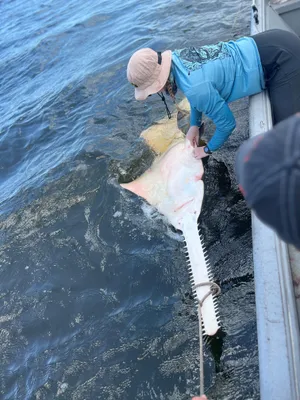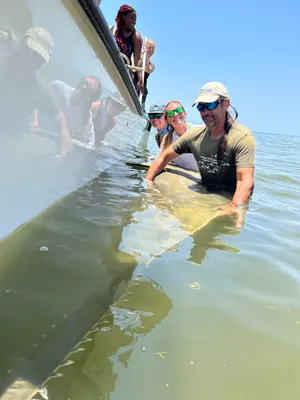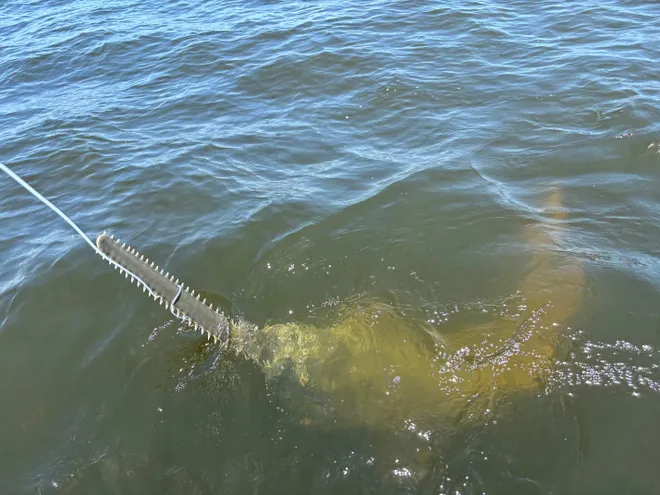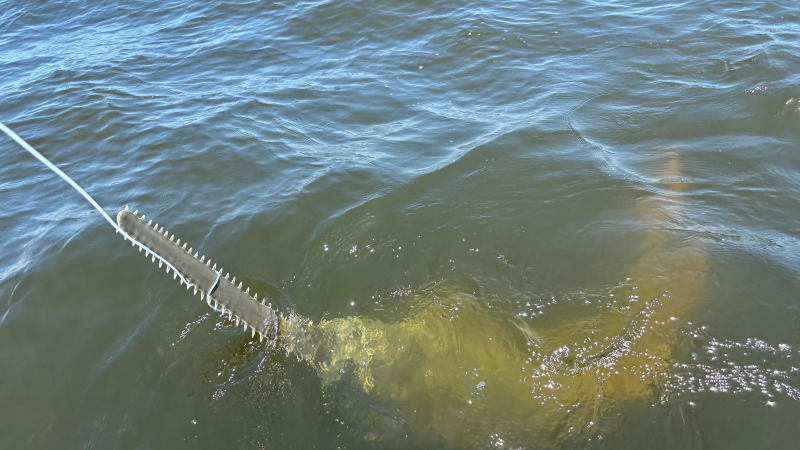'Prehistoric' relative of sharks struggle to make a comeback near Florida
For 16 years, Jim Gelsleichter and his students surveyed the waters in southeastern Georgia and northeastern Florida to learn more about the sharks, rays and other related species in the region.
In all those years, one fish remained elusive, the endangered smalltooth sawfish. But this summer, as a storm approached their boat in the St. Marys River at the end of the day, a student felt a tug on a line and quickly realized something big was on the other end.
Gelsleichter, a professor and coastal and marine biology flagship program director at the University of North Florida, jumped to help by grabbing the drum line they were using to lure and capture larger species.
“It was the heaviest thing I’d pulled on a drum line,” he said. “When I pulled it, I was thinking: ‘Wouldn’t it be funny if it was a sawfish.’”
Sure enough, a sawfish nearly half the length of their 21-foot skiff emerged, with its long, tooth-lined snout wrapped in the line. Gelsleichter and the students were “euphoric” at finding the rare animal.
A sawfish, a type of ray related to sharks, is immediately recognizable by its snout, also called a rostrum or saw. Often dubbed "prehistoric," scientists studying fossils say sawfish evolved from ancient species. They are a species of elasmobranch, a group including rays, skates and sharks, that have no bones or skeletons, only cartilage, and they eat fish, shrimp and crabs.
Finding the sawfish at the Florida/Georgia border and the news of a sawfish caught off Central Florida’s east coast earlier this month are positive signs in what has been a year of bad news for the beleaguered animals. Gelsleichter also sees it as a chance to raise awareness about this rare species and the fight for its recovery.
Once found along coasts from Texas to New York, its population declined dramatically during the last half of the last century and sightings in the U.S. shrank to Florida. Reaching lengths up to 16 feet, sawfish were caught in nets as bycatch and their hedge-trimmer like saws were considered fishing trophies.
Outside the U.S., the smalltooth sawfish are also found in the Bahamas and reports suggest they may also be found in other locations off Central America, according to the National Oceanic and Atmospheric Administration.

Bringing back the sawfish
Florida adopted protections in 1992 and the U.S. population of sawfish was the nation’s first native marine fish listed under the Endangered Species Act in 2003. By that time, the fish were only found in pockets of Southwest Florida, said Dean Grubbs, associate director of research and a research professor at Florida State University’s Coastal and Marine Laboratory.
Grubbs is a member of the Sawfish Recovery Team, assembled by NOAA's office of protected resources to develop plans to recover the fish. It includes other experts and the Florida Fish and Wildlife Conservation Commission. “There’s a lot of people involved,” he said.
After two decades of effort, the sawfish were showing signs of recovery:
- At least 100 adult sawfish had been tagged with acoustic transmitters to help track their movements.
- Pups, roughly 2 feet long at birth, were found in Tampa Bay.
- A few other sawfish sightings were reported along the East Coast.

All of these are positive signs of population recovery, Gelsleichter said.
“The protections we’d provided seemed to be reversing (the decline)," he said. "We're starting to see the animals on a more regular basis like we used to."
Troublesome illness emerges in sawfish
Then a deadly disease showed up last fall, a disease that causes some abnormal behaviors in marine species, including spinning around in the water. The first dead sawfish was reported in January. Since then, Grubbs said, at least 54 sawfish have been confirmed dead from the toxic disease, mostly in the middle and lower Florida Keys. Experts believe the number could be higher.
In April in the Florida Keys, a team rescued a sawfish for the first time, an ailing 11-foot fish, and took it to a care facility operated by Mote Marine Laboratory and Aquarium, with high hopes for its recovery, but after more than 20 days of rehabilitative care, the sawfish died.
State officials are working with other groups to investigate the cause of the disease and deaths, reported in more than 80 additional fish species, as well as several crab species.
This illness is not to be confused with "whirling disease," an invasive illness that affects freshwater fish through a parasite that damages the nervous system, said Kelly Richmond with Florida's wildlife commission. "Our investigation has not uncovered any evidence of a parasite or other communicable pathogen that could account for the recent behavioral anomalies and mortalities." That's the case for the sawfish, as well as bony fishes, she said.
The investigation continues into the potential role of harmful algal blooms and associated toxins, Richmond said. Researchers have taken biopsies, blood samples and water samples, but so far have reached no definitive answers.
Florida legislators set aside money to study the spinning disease, and Grubbs hopes some of the money will go to support research into the disease in sawfish.
“This big mortality event may be a significant setback for us in terms of recovery,” he said. “It will be some time before we figure out exactly how big of a setback it was.”

Public implored to report sawfish sightings
It's critically important for fishermen and boaters and anyone who’s in the water to report all sightings or catches of sawfish, which could be seen anywhere in the Southeast, the scientists say. The report should include estimated size, location, date, time and water depth.
How to report sightings:
- Report online at SawfishRecovery.org
- Call 844-4SAWFISH
- Email sawfish@myfwc.com
Fishers who hook one must handle it appropriately, keep it in the water at all times and quickly let it go.
In 2019, a Jacksonville commercial fisherman pled guilty to using a power saw to cut the rostrum off a live 12-foot sawfish off the Northeast Florida coast. He was sentenced to two years’ probation, a $2,000 fine and 80 hours of community service.

Field survey class yields rare opportunity
Gelsleichter teaches a field survey class where the students conduct surveys by boat looking for sharks and rays. He and his students study shark reproduction and pollutants in fish that impair reproductive biology.
Once they pulled the sawfish they caught up next to the boat, it was time to get to work, as quickly as possible. Because he’s included on a permit that allows him to work on sawfish, they took a couple of small biopsies for genetic research, measured the young male and shot some quick video. They also attached a NOAA tag and did a rostral tooth count.
This was only the second time in Gelsleichter’s decadeslong career that he’d been able to handle a sawfish. “I can’t even describe it,” he said. “For these undergraduates to get a chance to see something like this is the part of it I love the most.”
Dinah Voyles Pulver covers climate change, wildlife and the environment for USA TODAY. Reach her at dpulver@gannett.com or @dinahvp.
Disclaimer: The copyright of this article belongs to the original author. Reposting this article is solely for the purpose of information dissemination and does not constitute any investment advice. If there is any infringement, please contact us immediately. We will make corrections or deletions as necessary. Thank you.






